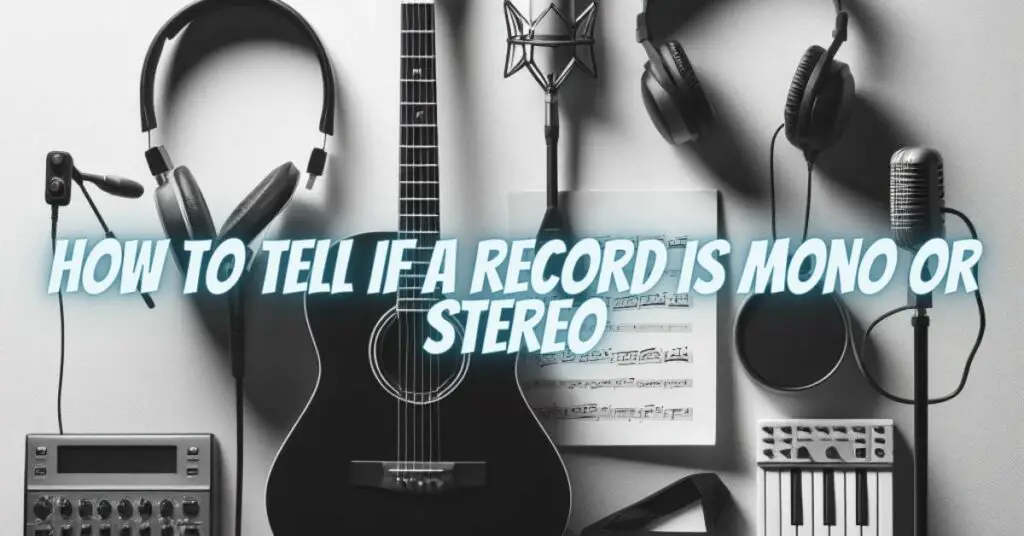Identifying whether a vinyl record is mono or stereo can enhance your listening experience and is particularly important for collectors and audiophiles. Here’s a comprehensive guide on how to tell if a record is mono or stereo.
1. Check the Record Label and Sleeve
- Label Information:
- Mono/Stereo Indication: Many records will clearly indicate whether they are mono or stereo on the label. Look for words like “Mono,” “Monophonic,” “Stereo,” or “Stereophonic” printed on the label.
- Catalog Number Prefixes: Some record companies use different catalog number prefixes to distinguish mono from stereo. For example, Capitol Records used “T” for mono and “ST” for stereo.
- Sleeve Information:
- Front and Back Cover: The record sleeve often contains information about the format. Look for mentions of mono or stereo on the front or back cover. Some albums, particularly those released during the transition period from mono to stereo, may have a sticker indicating the format.
- Cover Art: Stereo versions of some albums might have slightly different cover art or design elements compared to their mono counterparts. This is more common with older releases.
2. Listen to the Audio
- Channel Separation:
- Mono: In mono records, the same audio signal is sent to both the left and right channels. There will be no directional separation of instruments or vocals. When listening through headphones or stereo speakers, the sound will appear to come from a single point, without distinct left or right placement.
- Stereo: Stereo records have distinct left and right audio channels. Instruments and vocals are panned across the stereo field, creating a sense of space and directionality. For instance, you might hear the drums primarily in the left channel and the guitar in the right.
- Spatial Effects:
- Mono: The sound will be more centered and cohesive, with all elements blending together evenly.
- Stereo: You will notice spatial effects, with sounds moving or positioned within the stereo field. This creates a more immersive and dynamic listening experience.
3. Examine the Groove Pattern
- Groove Modulation:
- Mono: Mono records typically have uniform lateral (side-to-side) groove modulation. The groove pattern appears more consistent when viewed under a light.
- Stereo: Stereo records have both lateral and vertical (up-and-down) groove modulations, which can create a more complex groove pattern. This might be more difficult to discern without specialized equipment, but a close visual inspection can sometimes reveal differences.
- Use a Stereo Microscope:
- Detailed Inspection: For a more precise determination, you can use a stereo microscope to examine the grooves. Stereo grooves will have more intricate modulations compared to the simpler lateral modulations of mono grooves.
4. Consult Reference Guides and Databases
- Online Resources:
- Discogs: Websites like Discogs provide detailed information about different pressings of records, including whether they are mono or stereo. You can search by catalog number, artist, or album title.
- Collector Forums: Online forums and communities of record collectors often discuss the specific details of various pressings, including mono versus stereo distinctions.
- Record Guides:
- Collector’s Books: There are many books and guides dedicated to vinyl records that provide detailed information about different pressings, including mono and stereo versions. These can be valuable resources for collectors.
5. Use an Audio Analyzer
- Software Tools:
- Digital Audio Workstations (DAWs): You can digitize a portion of the record and analyze it using audio software. Tools within DAWs can display the waveform and help you see if there are two distinct channels (stereo) or a single channel (mono).
- Audio Analysis Plugins: Plugins that analyze phase and channel information can confirm whether a recording is mono or stereo by displaying the audio signal’s channel separation.
Conclusion
Determining whether a vinyl record is mono or stereo can be accomplished through various methods, including checking the record label and sleeve, listening to the audio for channel separation, examining the groove pattern, consulting reference guides, and using audio analysis tools. Each method provides valuable clues that, when combined, offer a comprehensive understanding of the record’s format. Whether for accurate playback, collecting, or simply for curiosity, knowing how to identify mono and stereo records enhances your appreciation of vinyl music.

